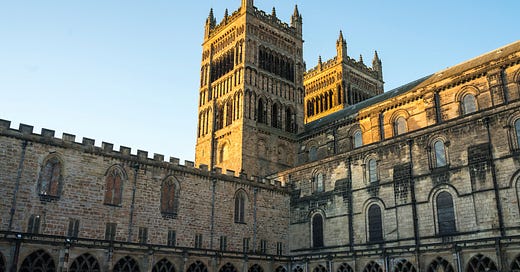Harry Potter and the Moral Imagination
In one of several significant scenes in Harry Potter and the Philosopher’s Stone, the action is framed by the architecture of Durham Cathedral, where I have been employed since 2019.
It takes place just after Harry (Daniel Radcliffe) discovered a magical mirror, the ‘Mirror of Erised’, which reflected not only the one looking into it, but also ‘the deepest and most desperate desires of our hearts’. Harry, an orphan, saw the parents he lost to the dark wizard, Voldemort, and the image called to mind the origin of his journey. In seven installments (eight films), Harry undertook the daunting and ultimately self-sacrificial task of saving the wizarding world from Voldemort and thereby vindicating the claim, fundamental to the series’ moral imaginary, that love is stronger than death. Harry was discovered contemplating the mirror by his headmaster, Albus Dumbledore (Richard Harris), who offered some words of advice: ‘It does not do to dwell on dreams, Harry, and forget to live.’
In the subsequent scene, Harry walks through the Cathedral’s cloister garth, generously dusted with winter snow, accompanied by his pet owl, Hedwig, released into a soaring upward flight. The white bird stands out against the Cathedral’s dark stone and, as she flies, the atmosphere shifts, as though in acceptance and realisation of Dumbledore’s words, from a winter of sombre reflection, a winter of dreams, to a springtime of friendship and promise, a springtime of new life. The scene is a moment of graceful transition in the unfolding narrative, which allows the viewer to take stock and to infer the significance of events from the beauty of their surroundings. The Cathedral’s architecture adds weight, a kind of moral seriousness, to Harry's experience.
Just as the architecture of our buildings helped to shape the image of Harry’s school, Hogwarts, in the minds of filmgoers, so the architecture of the Christian faith, and the Christian moral imagination, shaped the story in which it appears.
The Harry Potter series was not conceived as a Christian allegory; Hogwarts is not Narnia. The imaginary world created by C. S. Lewis, for the children of an earlier generation, was more truly epic. Like J. R. R. Tolkien’s ‘Middle Earth’, Lewis’s landscapes of thought and experience operate on a grander scale, with historical pasts and almost eschatological futures, diverse languages, and warring civilizations. Lewis’ and Tolkien’s stories unfold in alternative, even metaphysical, worlds, which turn readers into adventurers as they join characters on quests from the familiar—the Shire in The Hobbit (1937) and a country house in The Lion, the Witch and the Wardrobe (1950)—into the unknown and even the otherwise inconceivable. The landscape of Harry Potter is much less ‘exotic’; Hogwarts, the central arena of Harry’s magical adventures, evokes the traditional British public school.
Despite many differences, however, the Harry Potter series may also be described as a work of the Christian moral imagination. As a result of its explorations of themes of grief, power, friendship, loyalty, and many others, along with a fundamental assertion of the triumph of goodness and love, J. K. Rowling’s story lives up to the 'truth-seeking, truth-revealing' character of art, once asserted by Iris Murdoch, the Oxford philosopher and best-selling novelist. By its own autonomous narrative and its ‘mimetic’ quality, imitating the world around us, the story of Harry Potter gives form to the ‘mess’ of real life; Murdoch described this mess as our ‘rubble world’.
In The Hobbit, hero Bilbo Baggins is tricked by a wizard, Gandalf, into opening his home and ultimately his heart to a travelling party of dwarves. In The Lion, the Witch and the Wardrobe, young heroine, Lucy, stumbles through a wardrobe into the waiting arms of a faun, Mr Tumnus. Not dissimilarly, Harry Potter’s adventure begins accidentally, with the revelations that his true identity as a wizard has been kept secret from him, and that he is bound for life to his parents’ murderer. Accidental happenings plunge Bilbo, Lucy and Harry alike into a new dimension of life, from which there is no escape except by means of difficult choices.
Such is the fate of most human beings, at some time in our lives. We rarely choose to face life-altering, even life-threatening, moral dilemmas; we become moral agents simply because of our circumstances. Bilbo, Lucy and Harry are ‘every-people’, accidental moral decision-makers who are fortunate enough to find within themselves unexamined and untapped stores of strength and resourcefulness. Through Harry, as well as a wider cast of morally ambiguous characters, Rowling’s stories hold up a mirror to human life in general, revealing values of right and wrong, and even helping audiences—especially, perhaps, young people—to cultivate empathy, make sense of certain kinds of experience, and perhaps even improve moral judgments.
Since Rowling’s first novel was published in 1997, Harry Potter has transformed the landscape of children’s literature across the world—the books have been translated into 80 languages and sold over 500 million copies—yet this universal significance has had a very particular resonance for Durham Cathedral on account of our involvement in the films. Today, it is not unusual to see a little Harry Potter running around the cloister in search of the Chapter House, used as the classroom of Harry’s formidable Transfiguration teacher, Professor McGonagall (Maggie Smith). Our hope is that the relationship between Harry Potter and the Cathedral may work both ways; namely, that some of those who arrive in search of Harry Potter will discover, in addition, Saints Cuthbert and Bede, and the truth to whom their stories much more emphatically point.1
An earlier version of this post was prepared for the blog at Durham Cathedral.



